Abstract
The search for alternatives that can replace conventional materials extracted from nature is crucial for environmental sustainability. This is especially the case for construction and geotechnical engineering, as this sector is a major consumer of the planet’s natural resources. This paper explores the use of ore sand (OS) tailings with fine aggregate characteristics, which are generated during exploration of iron ore and usually stored in stacks, in terms of their potential for replacing conventional aggregates (gravel, natural sand, and limestone sand) used in interlocking paving blocks for light-traffic pavement. A comparative life cycle assessment (LCA, cradle-to-gate) approach was applied for aggregates in interlocking blocks produced using OS compared to blocks produced with conventional aggregates. The OS was able to replace 24wt% of conventional aggregates (100% limestone sand and 13.3% natural sand), while maintaining compressive-strength performance similar to that of the conventional block (35 MPa). For all eleven environmental-impact categories evaluated in the LCA, the block with OS has improved environmental performance compared to the conventional block. Through the creation and use of a scoring indicator (SI), it was possible to determine that the transport distance of the OS is a limiting factor for the environmental efficiency of the alternative block. Nonetheless, the incorporation of OS mitigates the impacts of block production on eutrophication, acidification, fresh water, human toxicity, and abiotic depletion. The use of tailings reduces the demand for natural resources, decreasing the environmental impact of production and promoting sustainable construction practices.
1. Introduction
The construction industry continues to grow due to housing shortages, the need for modern infrastructure and urbanization, and other factors. Its activity is responsible for a large demand for natural resources, contributing to the consumption of 4.27 billion tons of cement [1] and 50 billion tons of aggregates (gravel and sand) per year worldwide [2]. Sand and gravels are mined worldwide, with aggregates accounting for the largest volume of solid material extracted globally [3]. In Brazil, approximately 500 million tons of aggregates are consumed annually. These aggregates are mostly employed in cementitious materials used for construction and civil-engineering applications [4].
As a result, the search for alternative raw materials is essential to creating a more sustainable construction industry. Mine tailings can be a promising source of substitutes for natural raw materials, with a worldwide availability that can reach up to 60 billion tons [5]. All countries that conduct ore extraction generate mining waste. Brazil, India, China, and Australia are major producers of iron ore in the world and are consequently the largest sources of iron ore tailings [6]. It is estimated that in Western Australia, 632 million tons of iron ore tailings are produced per year [7]; in China, approximately 600 million tons are generated [8]; and in India, the data are not precise, but the amount is up to 20 million tons [9]. Around the world, this resource has been usually stockpiled behind dams, with attendant latent environmental and social risks [10,11]. In the state of Minas Gerais (Brazil) alone, 290 million tons per year of tailings are generated from mining activity [12]. Iron ore mining generates large amounts of tailings (on the order of 0.48 tons for each 1.0 ton of iron ore concentrate), and this amount tends to increase with the depletion of the metal concentration in the deposits [13]. Studies have shown that iron ore tailings (IOTs), also called ore sand (OS), have characteristics that can enable them to be effectively used in construction as a substitute for natural sand [14].
Mine tailings have been studied in terms of their use as a fine aggregate for the production of concrete [15,16], geopolymers [17,18] ceramic materials [19,20], and pigments [21]. Along the same lines, mine tailings can be used for the production of interlocked blocks, which have been utilized on a large scale for paving in Brazil. The growth in the production of interlocked blocks is due to their reduced repair cost, easy installation and reusability; more than 90% of the blocks are reused. Vilaça et al. [13] systematized the recovery of iron ore tailings using the criteria of classification, potential, quantity/viability, and applicability for four possible uses: asphalt pavement; aggregate for pavers; aggregate for mortar; and aggregate for ceramic products. Through the critical index developed by the author, the use in block pavers allows for IOTs to be valued and used in symbiosis with industry.
Ravi et al. [22] investigated the properties of interlocking concrete block paver mixed with IOT as a partial replacement for cement. For M25 concrete, the addition of varying levels of iron ore tailings resulted in an increase in compressive strength with IOT levels from 5% to 15% and decrease in compressive strength for IOT levels from 15% to 25%. Santana Filho et al. [23] studied the use of IOTs as a fine aggregate in the production of interlocking concrete blocks, replacing natural aggregate in proportions from 10 to 80%. Physical analyses, environmental analyses (leaching and dissolution), and mechanical tests were performed. The authors concluded that IOTs can be technically and environmentally used for the production of precast concrete blocks. According to Brazilian standards (NBR 9781 [24]), the fundamental materials for the manufacture of interlocking blocks are binders, aggregates, and water, with the use of additives and pigments being allowed.
Despite the applicability of IOTs in construction, it is necessary to evaluate the environmental benefits of replacing aggregates with mining waste. For example, Saldanha et al. [25], verified that the use of IOTs as raw material in the production of sodium silicate for soil stabilization reduces environmental impacts because it avoids the extraction of natural sand. The focus of that work was on the production of sodium silicate using IOT as a source of silicates in the production of a binder. Garcia-Troncoso et al. [26] studied concrete produced with mining waste. Using life cycle analysis, the author examined the replacement of natural sand with tailings at different content levels (5% to 100%). A 3% reduction in the carbon footprint was found in the case of 100% replacement of sand by tailings. However, the environmental impact associated with the transportation of materials represents a possible restriction in the search for environmentally friendly concrete produced using waste [27].
Liu et al. [28] used IOTs as a cementitious composite to improve the mechanical properties of the composite while helping to reduce the environmental burden of production. These authors evaluation LCA in five impact categories: photochemical ozone-creation potential, acidification potential, global-warming potential, ozone-depletion potential and nitrification potential, and found that incorporation of IOTs into concrete reduces the environmental impact of production, which consolidates the possibility of achieving clean production with the use of IOTs to prepare cementitious composites. Nevertheless, that work is more focused on the mechanical and microstructural aspects of using tailings in concrete, with the LCA being used superficially. Gao et al. [29] also briefly evaluated the environmental impacts of using molybdenum mining tailings to replace fine aggregates in structural concrete. Additionally, in both studies, the life cycle assessment is focused on the completed concrete (cement and aggregates), not just the aggregates that compose the blend. A comparative LCA between aggregates highlights the environmental importance of using waste. In general, LCA studies of the use of IOT have focused mainly on cement mortars. Evaluations of their use as an aggregate for interlocking blocks are still lacking. Brazil alone has the potential to consume around 2.5 million tons of ore sand per year as fine aggregate in the paving of its roads [23].
In this context, no studies were found that carried out a more focused environmental life cycle assessment for the replacement of conventional aggregates by ore tailings in interlocking concrete paving blocks, along with the influence and limits imposed by the transportation of the alternative aggregate for the production of this civil construction product. Hence, this study investigates the environmental impact of utilizing ore sand in constructing interlocking paver blocks and assesses how the distance from the source of tailings generation impacts the life cycle environmental footprint of these materials. The application of LCA to the construction sector is part of a wide effort to implement LCA as a decision-support tool for industry and policy [30]. Therefore, research on the mechanical feasibility of using mining tailings to replace natural resources and on their environmental impact (considering other relevant categories beyond CO2 emissions) is key to developing more sustainable products.
The objective of this research is to assess sustainability by considering the environmental benefits of utilizing ore sand as a substitute for conventional aggregates (natural sand and limestone sand) in the production of interlocking concrete block pavement and to evaluate the impact of ore-sand transportation on environmental assessment. The compressive strength of both alternatives (conventional and ore-sand blocks) was evaluated and compared. A comparative life cycle assessment was carried out to assess eleven categories of environmental impacts and determine the environmental performance of the aggregates used in the production of the blocks. Using a proposed scoring indicator in conjunction with life-cycle impacts, it was possible to determine a maximum distance for the environmentally sustainable transportation of ore sand used in the production of interlocking concrete paving blocks.
2. Materials and Methods
2.1. Iron Ore Tailings
Ore sand (OS) was obtained from the Itabira complex in the state of Minas Gerais, which has potential to produce 130,000 tons of ore sand per year. Physical test data showed that the material has a specific gravity of 2.75, a unit mass of 1.49 g/cm3, a fineness modulus of 0.5, and a water-absorption rate of 0.7%. The particle-size distribution indicated that the ore sand is considered a fine aggregate (0.06 mm < diameter < 0.2 mm), with 26% powdery material (<0.075 mm). Per the results of X-ray fluorescence tests, the OS is composed of 87.9% SiO2, 10.25% Fe2O3 and 0.19% Al2O3. Its mineralogical composition (Figure 1) is largely quartz, hematite and illite. According to Zhang et al. [31], the compositions of mining tailings depend on the physical and chemical characteristics of the iron ore sources and are very specific to the extraction site. The grain-size distributions of the ore sand studied here and of the other aggregates used are shown in Figure 2. The D30, curvature coefficient (Cc) and uniformity coefficient (Cu) for the materials used are, respectively, (i) ore sand D30 = 95, Cc = 0.9 and Cu = 2.6; (ii) limestone sand D30 = 90, Cc = 0.1 and Cu = 27.5; (iii) natural sand D30 = 280, Cc = 1.0 and Cu = 7.8; and (iv) gravel D30 = 1110, Cc = 1.1 and Cu = 2.6. The ore sand is well graded, with diameters varying over a short range, and more uniform than the limestone sand it replaced, promoting better filling of the voids in the mixture of gravel and natural sand.

Figure 1.
X-ray-diffraction results for the ore-sand sample.
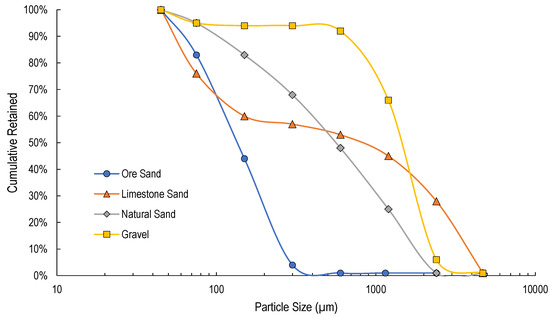
Figure 2.
Particle-size distributions of the aggregates.
2.2. Production of Pavers
The relative amounts of components used by local companies were applied to the production of the traditional blocks. For the blocks constructed with OS, the proportion of aggregates was determined based on the ideal granulometry for block production. Pilot tests were performed in a block factory, where the ideal amount of aggregates to use in molding the blocks was determined. Based on these preliminary results, it was found that ore sand could replace 100% of the limestone sand and part of the natural sand (13.3%). The ordinary Portland cement (OPC) was the same for both blocks tested. This additive is a plasticizer. It was obtained in the regular market and used for all mixtures tested. This additive enables dry concrete to be produced with less water, improving the plasticity and lubricity of the compound. Table 1 shows the proportion of each material used for the production of interlocking blocks.

Table 1.
Mix ratios used to produce 60,000 interlocking concrete blocks.
The blocks were produced in a factory specialized in manufacturing these components. The mixing of the raw materials is automated, and the compaction of the dry concrete is finished in a hydraulic vibro-press. The produced pavers have a parallelepiped format with the dimensions 100 mm × 200 mm × 80 mm. After molding, the specimens were cured in a humid room (above 98% relative humidity). The compression test was performed after 15 and 28 days of curing, per the Brazilian standard [24]. For the strength test, standards require samples (blocks) to be saturated 24 h before the test, loading surfaces to be straight, auxiliary plates to be used, and loading to be carried out continuously at 550 kPa/s until complete rupture with equipment Class 1 (ISO 7500-1 [32]). Six replicate samples of each mixture were tested for conventional and OS block pavers. Interlocked paving blocks subject to light vehicle traffic must have an estimated minimum typical compressive strength of 35 MPa [24].
2.3. Life Cycle Assessment
The environmental assessment was conducted in accordance with ISO 14.040/14.044 [33,34] and encompassed four primary phases: (i) goal and scope determination, (ii) inventory analysis, (iii) impact assessment, and (iv) interpretation of results. LCA is a systematic method for assessing the environmental impacts of products or processes throughout their entire life cycle, from raw-material extraction to production, use, and end-of-life disposal or recycling. These standards provide a comprehensive methodology for conducting such assessments and offer a flexible framework that allows for customization to meet the specific needs of the LCA study.
The evaluation of environmental impact was carried out using the LCA software SimaPro version 9.3 [35]. The software was used to (i) assist in structuring the flowchart of processes established in the goal and scope of this work; (ii) access the life cycle inventory database to obtain inputs and outputs of raw materials, energy, emissions, and waste for all the analyzed processes that generate environmental impacts; and (iii) apply the CML 2001 life cycle impact assessment method, which quantifies impacts in categories.
2.3.1. Goal and Scope
The life cycle assessment compared the environmental impacts of two sets of aggregates for the production of 60,000 interlocking concrete blocks with the same load capacity (functional unit). The first alternative corresponds to a conventional block produced with natural aggregates (gravel, sand, and limestone sand), and the second alternative (ore sand block) was produced by partial replacement of natural aggregates with OS.
The LCA involved a cradle-to-gate analysis of the production of aggregates. The process of molding the blocks is the same for both mixtures; thus, the production process was not analyzed. Concrete blocks can have different applications (i.e., paving of roads and sidewalks, parking lots, and outside areas of houses); thus, the impacts related to use and end of life were not considered. The two systems studied are shown in Figure 3, and all emissions associated with energy and the production of raw materials are considered. The system for the ore sand block consists of (1) production of the gravel; (2) production of the natural sand; (3) transport of gravel and natural sand; and (4) transport of IOT sand. The ore sand was considered a waste product and thus was considered not to have any environmental impact associated with its production. The system for conventional blocks consists of (1) production of the gravel; (2) production of the natural sand; (3) production of limestone sand; (4) transport of gravel, natural sand, and limestone sand.
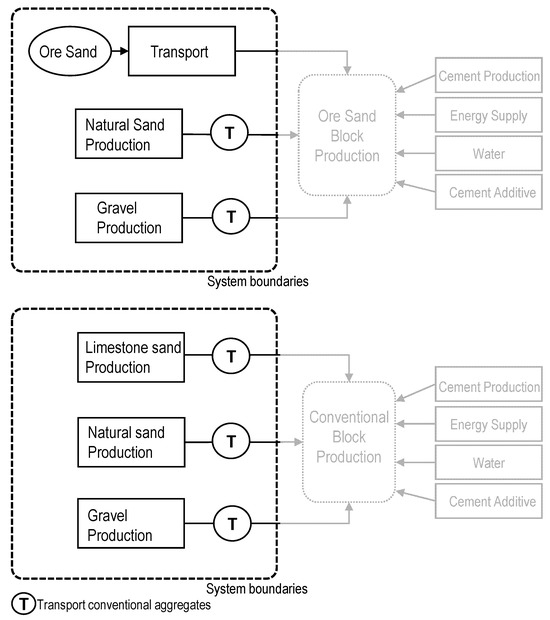
Figure 3.
System boundary defined to produce interlocking blocks [35].
An assessment of the environmental impact of transporting ore sand was carried out to determine the influence of the transportation distance of this material on the production of the blocks. Six distances (50, 100, 200, 400, 800, and 1600 km) were established for truck and train conveyance. Trains are normally used in Brazil to transport mining materials. The average diesel consumption for road transport is 1.9 × 10−2 Ldiesel/km.t, and the consumption for the freight rail system is 3.6 × 10−3 Ldiesel/km.t. These data were obtained from local companies that transport this material. Calculations involving the transportation of conventional aggregates were based on the average distance traveled by these products to the block factory: 10 km for gravel and limestone sand and 60 km for natural sand. Transportation of such materials is usually carried out by truck.
2.3.2. Inventory Analysis
Life cycle inventory (LCI) enables the collection, structuring, and analysis of data associated with the inputs and outputs of raw materials, energy, emissions, and waste at all stages of a life cycle process. Secondary inventory data was obtained from the Ecoinvent 3.8 database [36] using SimaPro software and from the literature. Table 2 summarizes the inventory data employed in the calculations associated with the conventional block and the ore sand block used for evaluation. The data for natural sand were for extraction from rivers, which corresponds to 70% of the production of this material in Brazil [37]. There are no specific data regarding the production of limestone sand, but its production process is similar to that of gravel, with quarrying, crushing, and screening; consequently, the same data inventory used for gravel was used for limestone sand.

Table 2.
Inventory process database for the IOT block and conventional block aggregates.
2.3.3. Impact Assessment
Life cycle assessment evaluates environmental effects based on LCI data, using methods and indicators that quantify the impact in different categories. The impact assessment was performed in SimaPro software. It applied the CML 2001 method [41] and involved the following impact categories: abiotic depletion, fossil-fuel depletion, global warming, ozone depletion, potential for human toxicity, potential for freshwater aquatic ecotoxicity, potential for marine aquatic ecotoxicity, potential for terrestrial ecotoxicity, photochemical oxidation, acidification, and eutrophication.
For the transport assessment, a scoring method (score indicator) was used. This method combines the results of the eleven impact categories obtained with the CML 2001 method into a single score, making it easier to compare the cumulative impacts across the different distances considered. The ratios between the results obtained in each impact category between the two blocks are metrics that compare the performance of the OS Block (V) to that of the conventional block (Vt). Higher proportions indicate a more significant difference between the products being compared. This evaluation format is commonly used in performance management, strategic planning, project evaluations, and evaluation of company goals [42].
All impact categories were given equal weight in the present analysis. The Score Indicator (SI) is the sum of the results of relative impact for each category (V/Vt) for each of the systems evaluated and divided by the number of impact categories assessed (n). The equation (Equation (1)) used is shown below:
where V is the value (result) of the impact category obtained for each distance variation, Vt is the value of the impact category for the target product (e.g., conventional block), and n is the number of impact categories evaluated.
3. Results
3.1. Compressive Strength of the Blocks
Figure 4 shows the results of compressive-strength tests for the compared blocks. The compressive strength of the block with IOT is similar to that of the conventional block. After 15 days of curing, the ore sand block presented a strength of 37.87 MPa. The Brazilian standard [24] establishes that this strength must be 80% (28 MPa) of the expected strength for light traffic paving. Both blocks meet this requirement. After 28 days of curing, the ore-sand block presented strength higher than that established in the standard (35 MPa) and higher than that of the conventional block. Therefore, the results meet the minimum requirements of the Brazilian standard, as well as of the requirements of the European and British standard BS EN 1338:2003 [43], the Indian standard IS 15658 [44], and the Egyptian standard ESS 4382 [45], which establish a strength of 30 MPa as the minimum acceptable. However, the American standard ASTM C936 [46] specifies a value of 50 to 55 MPa. A cone-shaped fracture with vertical crack [47] was identified in the compression tests for both blocks analyzed.
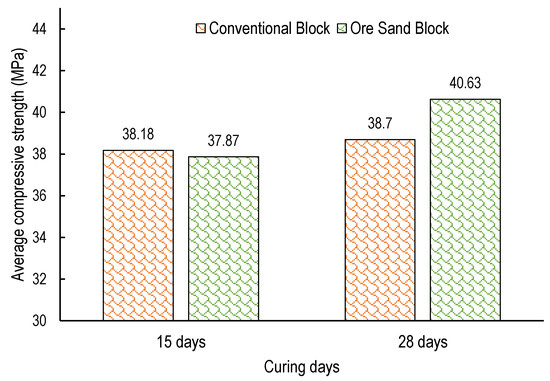
Figure 4.
Comparison of the compressive strengths of the blocks.
The blocks constructed with ore sand were homogeneous and dense (Figure 5). The limestone sand has fine granulometry and works as a filler in the block. Thus, the total replacement of this material by ore sand that had finer granulometry and that was well graded and more uniform resulted in better packing, reducing the voids and resulting in better mechanical performance of the ore-sand blocks compared to the limestone-sand blocks [48,49]. According to Mendes Protasio et al. [50], ore sand reduces the porosity of the material by increasing the contact surface between the particles, promoting performance that is satisfactory and even superior compared to that of blocks made with natural sand. The results obtained for mechanical strength show that the blocks have similar performance and can be considered products of the same standard category. They are therefore comparable in the environmental-performance assessment.

Figure 5.
Visual aspect of the block produced using iron-ore sand.
3.2. Production Impacts
As part of the scope and goal of this work, the environmental impacts of the aggregates used to manufacture conventional paving blocks and paving blocks with the addition of ore sand were evaluated. With the data obtained from the life cycle inventory analysis of aggregate production (Table 2), it was possible to quantify the environmental impacts of block production in eleven impact categories using the CML 2001 method. Figure 6 shows the comparative results (highest result divided by the lowest) in each of the impact categories for aggregates used to manufacture 60,000 blocks (excluding impacts associated with transportation). As noted in Section 2.3, only the impacts of producing the aggregates (not of manufacturing the blocks) are considered because the latter process is the same regardless of the aggregates used. Table 3 shows the results obtained for the categories evaluated with the percentage reduction in impacts with the replacement of natural resources by ore sand. A reduction in impact was observed for all categories, with abiotic depletion having one of the highest reductions. This category accounts for minerals and resources used and is influenced mainly by the rate of resource extraction [38,40]. To minimize abiotic depletion, sustainable practices in the extraction and use of non-living resources need to be promoted. Such practices include reducing consumption via recycling and circular-economy practices, developing more efficient extraction and processing techniques, and promoting the use of alternative and renewable resources. The replacement of 100% of the limestone sand and 13.3% (98.2 t to 85.1 t) of the natural sand with iron ore tailings resulted in an average overall reduction of 30% in all environmental impacts compared to using conventional aggregates in the manufacture of interlocked blocks.
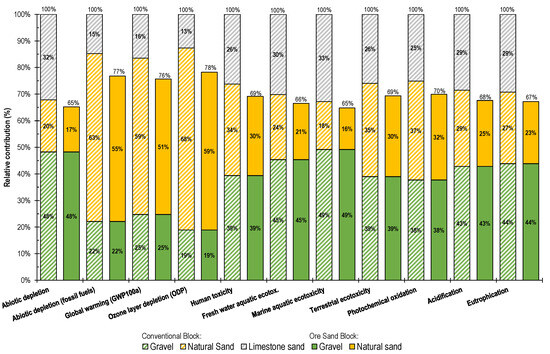
Figure 6.
Relative contribution to environmental impacts by each aggregate type used in conventional blocks and ore-sand blocks (excluding impacts related to the transportation of aggregates).

Table 3.
Environmental impacts of aggregates for the production of 60,000 blocks.
The graphical representation in Figure 6 illustrates the relative contributions of limestone sand, gravel, and natural sand to the impact categories assessed during the production of conventional and ore-sand blocks. These assessments follow the predefined limits established for life cycle assessment (goal and scope). The hotspots are the categories of abiotic depletion (fossil fuel), global warming and ozone depletion, which cause major impacts due to the extensive consumption of natural sand resources in manufacturing the blocks. These categories are related to the use and burning of fossil fuels in engines used in river dredging to obtain the sand, internal transportation from the river mine area to the port, and port processing operations [38]. The other eight categories are influenced by the extraction of gravel and limestone sand. Mining and crushing entail creating large exploitation areas where the outer layer of the soil is modified and the fauna and flora are eradicated, while also generating microparticles harmful to humans, among other negative effects [51,52]. Limestone sand with natural sand (used for the conventional block) contributes significantly in all categories evaluated. Using OS to replace these resources creates a reduction in such impacts ranging from 35% to 22%. The incorporation of waste with a granulometry similar to that of natural sand and gravel is one way to improve the performance of the block with tailings. Despite the reduction in environmental impacts associated with the use of ore sand in blocks, it is still necessary to determine the environmental impact of the transportation of aggregates to the manufacturing site in order to determine the environmental impact of using the ore sand.
3.3. Transportation Impacts
Within the predefined boundaries for life cycle assessment in this study, transportation is an important determinant of the environmental impact of aggregates used in the production of pavers. Figure 7 summarizes the impacts of production and transportation of the conventional aggregates, namely, natural sand, limestone sand, and gravel (detailed in Section 3.2). In this scenario, the environmental assessment includes the impact of the transportation of conventional aggregates. The average contributions of transportation to diesel burning for the conventional and alternative blocks were 22.7% and 25.6%, respectively. Figure 8 and Table 4 show only the impact of transporting such aggregates according to their type and quantity (Table 2). The greatest impact comes from the transportation of natural sand due to the large amount needed and the distance of this resource from the block factory site, which together result in higher diesel consumption. Gravel and limestone are transported the same distance, but the amount of gravel needed is greater than the amount of limestone needed, so gravel has a greater impact. Among the materials used in the block manufactured with ore sand, the transportation of natural sand had the greatest impacts across all the categories evaluated.
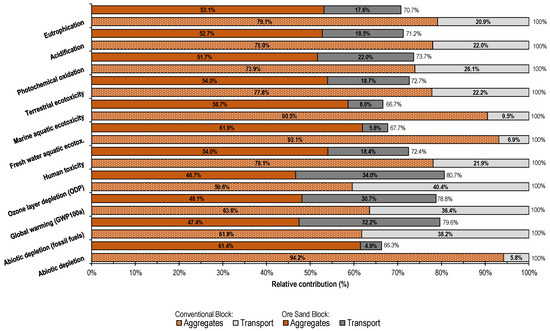
Figure 7.
Environmental impact of the production and transportation of conventional aggregates (natural sand, limestone sand, and gravel).

Figure 8.
Contribution of conventional aggregates to transportation impacts.

Table 4.
Environmental impact of the transportation of conventional aggregates (natural sand, limestone sand, and gravel) for the production of blocks.
To capture the complete environmental impact of the alternative block, it is essential to consider the transportation of ore sand from the storage or mining site to the block factory. More specifically, the break-even point, or the distance up to which the ore-sand block has a lower environmental impact than the conventional block considering the transportation of this waste, needs to be identified. Figure 9a and Figure 10a show the impacts for different transportation distances for the block manufactured using ore sand (in combination with the transportation impacts for the block constructed with conventional aggregates) by train and truck, respectively. The overall impact for each distance was calculated using the Score Indicator.
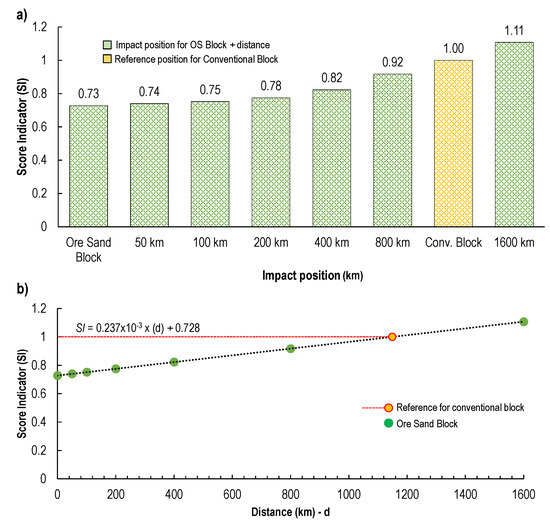
Figure 9.
Environmental impact score for the ore sand block: (a) impact for different transportation distances for OS materials by train; (b) break-even point with the conventional block.
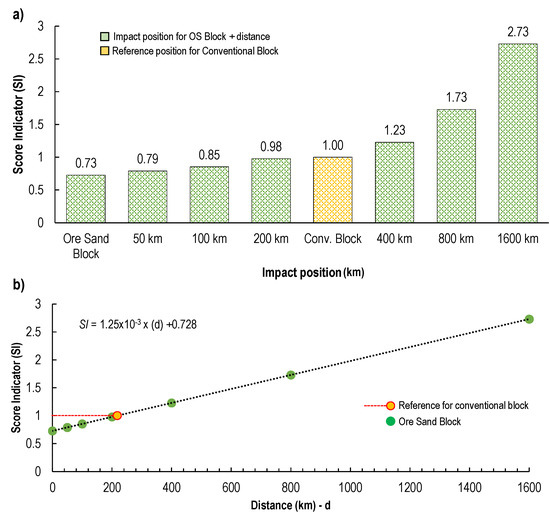
Figure 10.
Environmental-impact score for the ore-sand block: (a) impact for different transportation distances for OS materials by truck; (b) point at which the ore-sand block breaks even with the conventional block.
For example, for the global-warming category, the conventional block generates 7.2 × 102 kg of CO2 (Table 3) from the production of aggregates and an additional 4.14 × 10² kg of CO2 (Table 4) from transportation, totaling 11.4 × 10² kg CO2 (Vt). The block manufactured with ore sand generates 5.5 × 10² kg of CO2 from the aggregates and 3.5 × 10² kg of CO2 from transportation. Transporting ore sand (100 km) entails the burning of an additional 14.1 L of diesel, which generates 0.43 × 10² kg of CO2 (3.06 kg CO2/L), for a total of 9.4 × 10² kg CO2 (V). The ratio between the two results (V/Vt) for this category is 0.82. This process was carried out for all impact categories. Next, the ratios were summed and divided by the number of categories (n). For 100 km, the SI result was 0.75; for 200 km it was 0.78, etc., as shown in Figure 9a.
At distance zero, the environmental impact of the conventional block is compared to the alternative paver block without ore-sand transportation. The environmental performance of the paver measured by the Score Indicator at distance zero is 0.728 (~0.73), indicating reduced environmental impacts due to the use of ore sand in block production, as described in the previous section. Therefore, the OS block starts at an advantage over the conventional block, with an SI less than 1. This difference decreases when ore-sand transportation is considered.
For a transportation distance of 1,147 km by train and 217 km by truck for the ore sand, the alternative block has the same potential environmental impacts as the conventional block (Figure 9b and Figure 10b) considering the impacts of the and production and transportation of all aggregates. These values were obtained by establishing linear functions (Equations (2) and (3), for train and truck transportation, respectively) connecting the transportation distance for the ore sand to the Score Indicator. This result means that the ore-sand block is a most sustainable alternative in comparison to traditional blocks only when OS is transported less than 1147 km by train or 217 km by truck. It is important to highlight that both distances entail the same diesel consumption (162.2 L), but trucks are less efficient than trains in terms of the distance travelled per liter. Golev et al. [5] verified this same trend, where transporting ore sand by train causes a lower environmental impact in greenhouse gas emissions compared to road transport. Each liter of diesel used for transportation contributes to the following environmental impacts (per unit): 1.63 × 10−7 kg Sb eq. (abiotic depletion); 4.26 × 101 MJ (abiotic depletion—fossil fuels); 3.06 kg CO2 eq. (global warming); 5.46 × 10−7 kg CFC-11 eq. (ozone-layer depletion); 1.90 × 10−1 kg 1,4-DB eq. (human toxicity); 3.20 × 10−2 kg 1,4-DB eq. (freshwater aquatic ecotox.); 1.31 × 102 kg 1,4-DB eq. (marine aquatic ecotox.); 5.01 × 10−4 kg 1,4-DB eq. (terrestrial ecotox.); 4.64 × 10−4 kg C2H4 eq. (photochemical oxidation); 2.36 × 10−2 kg SO2 eq. (acidification); and 5.29 × 10−3 kg PO4 eq. (eutrophication) [35,39,41].
4. Discussion
In assessing the environmental performance of only the aggregates used to manufacture the interlocking paver blocks, the ore-sand block has a significant environmental advantage over the conventional block and has similar load capacity. This difference is explained by the replacement of 24% of the aggregate (by mass) with IOTs (a leftover), which creates an alternative with a lower environmental footprint in all eleven impact categories. In the context of this work, from a materials point of view, the ore-sand block has an advantage over the conventional block. However, the iron-mining areas are strategically located for iron extraction, in contrast to the areas for commercial natural-sand extraction, which are typically situated close to block factories. This feature demonstrates the importance of the transportation analysis performed here for the environmental appraisal of this alternative solution. Transportation represented an average of 22.7% of the environmental impact across the eleven impact categories evaluated for blocks constructed with conventional aggregates. This finding highlights the fact that the transportation of materials is important in assessing environmental performance. Sjunnesson [53] identifies the main contributors to the total environmental burden of concrete over its life cycle as the raw materials and transportation.
The Score Indicator enabled a comparison of the impacts of different transportation distances for the leftover ore sand. As the distance increases, the consumption of diesel burned by rail or road transport increases. The increase in the burning of fossil fuel leads to increases in the several categories, all of which were considered to have the same weight in this work. Figure 11 shows that SI = 1 for the V/Vt ratio, which corresponds to the distance values obtained with Equation (2) (1147 km) and 3 (217 km) for both transportation types. This figure shows the categories (photochemical oxidation, ozone layer depletion, global warming, and abiotic depletion-fossil fuels) that have an increase in impact (V/Vt > 1) in comparison to traditional blocks for distances above 1,147 km for train and 217 km for truck. However, for the other seven categories, the burning of diesel had a smaller impact compared to construction of conventional blocks (V/Vt < 1). The sum of the values (V/Vt) in the impact categories divided by the number of categories (n = 11) results in a value of 1.0, where the increase in certain categories is counterbalanced by categories with lower impacts compared to the conventional block. This result confirms that the equations developed from the SI were effective in determining the best distance for ore-sand transportation. The evaluation of several impact categories enhances the understanding of environmental trade-offs between analyzed systems [54,55]. Evaluating the performance of two products through the ratio of the impacts across environmental categories (V/Vt) is an established practice in life cycle assessment studies [56,57,58]. This approach provides an objective metric by which to identify categories with better or worse performance. Calculating category ratios simplifies complex environmental data, allowing for easier result interpretation through this metric.
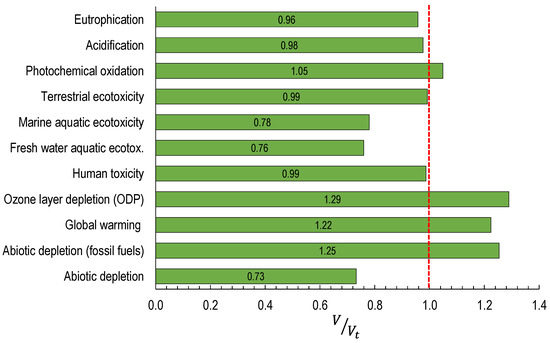
Figure 11.
Relative impact of the evaluated categories for the OS block with transportation (V) compared to the conventional block (Vt). The red line delimits which category is higher and lower than the conventional block.
The Scoring Indicator used in this study proved to be a useful and efficient tool for determining the increase in impacts due to transportation. It provides an equation that supports decision-making regarding the distance allowed for incorporating ore sand into interlocking paving blocks. Alternative models, such as the normalization and ranking of environmental indicators for decision-making [59] and MIVES (Spanish Integrated Value Model for the Sustainability Assessment) [60], are applicable, although they are complex. However, the latter model allows for the inclusion of broader considerations from studies that incorporate assessments in the environmental, social, and economic fields.
Figure 12 shows the potential range for the distribution and use of ore sand in block production, according to the distances calculated. The distribution of this sand can reach up to nine states via rail network and can reach several cities around the iron-ore mining area by road, enabling the production of an interlocking block with less environmental impact. Göswein et al. [27] conducted a study that employed a combination of LCA and geospatial analysis to assess the incorporation of fly ash and recycled construction waste into concrete in Portugal. Alzard et al. [61] also used a similar method to assess the environmental and economic impact of the transportation of construction waste to concrete plants in the United Arab Emirates. Estanqueiro et al. [62] emphasize the importance of regionalized (geography-specific) assessments, considering local production and transportation conditions to enhance accuracy.
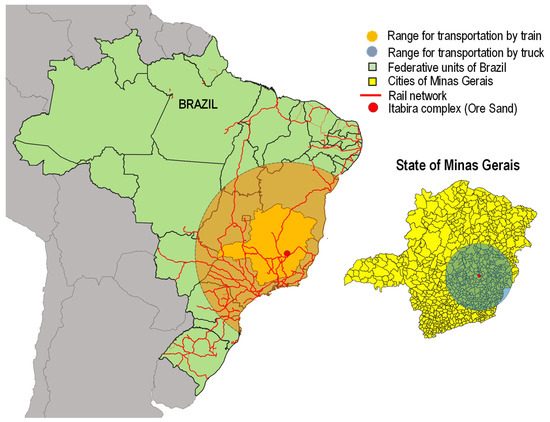
Figure 12.
Potential distribution of ore sand for use in producing an environmentally friendly block (map created using QGIS software v3.14 [63] and data from IBGE [64]).
Future research should focus on evaluating: (i) the potential to replace the cement used in the production of blocks with ore sand, which produces the same mechanical behavior; (ii) replacing natural sand with other left-overs (e.g., bottom ash) and its impact on the LCA; (iii) analyzing transport by waterway; (iv) analyzing databases from other locations and processes; and (v) assess sustainability across environmental, social, and economic aspects, in alignment with the UN’s Sustainable Development Goals.
5. Conclusions
Based on the objectives set and the findings of this research, the following conclusions can be drawn:
- The OS block has similar strength performance compared to the conventional block, meeting the established standard of 35 MPa.
- Ore sand is an environmentally sustainable alternative for use in the replacement of conventional aggregates used for the production of interlocked blocks. This study found an average reduction of 30% for the 11 impact categories compared to the traditional block.
- The transportation of conventional aggregates has a significant impact on the production of both blocks. It represents an average of 23.7% of the total impact for the ordinary block and 26% for the block produced with ore sand.
- Using the scoring indicator (SI), it was possible to establish that the transportation of ore sand for distances of 1147 km by rail and 217 km by road results in the same environmental impact for the ore-sand block as for the conventional block.
- Transportation distances shorter than those above make the block with ore sand more environmentally friendly than the conventional alternative. Over these distances, it is possible to reach other states in Brazil, as well as many cities (mostly inside the state of Minas Gerais) around the mining area that can supply other interlocking paving block factories.
- The LCA technique in association with SI proved to be a useful decision-making tool in defining the transport distance that makes it possible to manufacture an environmentally responsible block.
Within the limits set, this work offers an innovative LCA-based approach to evaluating the environmental performance of interlocking paving blocks constructed with ore sand as an aggregate and the limiting effects of transportation on their production. The incorporation of ore sand into the interlocking paving block confers environmental benefits to the product, increasing the environmental sustainability of the industry. The method presented can be adapted to different locations, allowing the determination of an environmentally safe distance between the tailings-generation site and the production sector.
Author Contributions
Conceptualization, R.B.S., M.F.L.M., R.J.B. and N.C.C.; methodology, R.B.S., M.F.L.M., R.J.B. and N.C.C.; validation, R.B.S. and M.F.L.M.; formal analysis, R.B.S. and M.F.L.M.; investigation, R.B.S. and M.F.L.M.; data curation, R.B.S. and M.F.L.M.; writing—original draft preparation, R.B.S., M.F.L.M., R.J.B. and N.C.C.; writing—review and editing, R.B.S., M.F.L.M., R.J.B. and N.C.C.; supervision, N.C.C.; project administration, N.C.C.; funding acquisition, N.C.C. All authors have read and agreed to the published version of the manuscript.
Funding
The authors wish to make explicit their appreciation to VALE S.A. (IAP-001247 and IAP-001466) and CNPq (Brazilian Research Council) for the support to the research group.
Institutional Review Board Statement
Not applicable.
Informed Consent Statement
Not applicable.
Data Availability Statement
The data presented in this study are available on request from the corresponding author. The data are not publicly available due to ethical considerations and potential future publications.
Conflicts of Interest
The authors declare that this study received funding from VALE S.A. The funder was not involved in the study design, collection, analysis, interpretation of data, the writing of this article or the decision to submit it for publication.
References
- Global Cement Market. Analysis by Production, by Consumption, Type (Blended, Portland and Others), by Application (Non-Residential and Residential), by Region, Size and Trends with Impact of COVID-19 and Forecast up to 2027; Global Cement Market: Dublin, Ireland, 2022. [Google Scholar]
- United Nations Environment Programme—UNEP. Sand and Sustainability: Finding New Solutions for Environmental Governance of Global Sand Resources: Synthesis for policy makers; United Nations Environment Programme: Nairobi, Kenya, 2019. [Google Scholar]
- Sand, rarer than one thinks. Environ. Dev. 2014, 11, 208–218. [CrossRef]
- National Association of Aggregates Producers for Construction—ANEPAC 2019. Environmental Overview of Mining. Available online: https://www.anepac.org.br/ (accessed on 9 November 2022).
- Golev, A.; Gallagher, L.; Velpen, A.V.; Lynggaard, J.R.; Friot, D.; Stringer, M.; Chuah, S.; Arbelaez-Ruiz, D.; Mazzinghy, D.; Moura, L.; et al. Ore-Sand: A Potential New Solution to the Mine Tailings and Global Sand Sustain-Ability Crises: Final Report; The University of Queensland: Brisbane, QLD, Australia; The University of Geneva: Geneva, Switzerland, 2022. [Google Scholar] [CrossRef]
- United States Geological Survey—USGS. Mineral Commodity Summaries, Iron Ore. 2020. Available online: https://pubs.usgs.gov/periodicals/mcs2020/mcs2020-iron-ore.pdf (accessed on 5 September 2023).
- Kuranchie, F.A.; Shukla, S.K.; Habibi, D. Electrical resistivity of iron ore mine tailings produced in Western Australia. Int. J. Min. Reclam. Environ. 2014, 29, 191–200. [Google Scholar] [CrossRef]
- Han, F.; Li, L.; Song, S.; Liu, J. Early-age hydration characteristics of composite binder containing iron tailing powder. Powder Technol. 2017, 315, 322–331. [Google Scholar] [CrossRef]
- Das, S.K.; Kumar, S.; Ramachandrarao, P. Exploitation of iron ore tailing for the development of ceramic tiles. Waste Manag. 2000, 20, 725–729. [Google Scholar] [CrossRef]
- Dávila, R.B.; Fontes, M.P.F.; Pacheco, A.A.; Ferreira, M.S. Heavy metals in iron ore tailings and floodplain soils affected by the Samarco dam collapse in Brazil. Sci. Total Environ. 2020, 709, 136151. [Google Scholar] [CrossRef]
- Armstrong, M.; Petter, R.; Petter, C. Why have so many tailings dams failed in recent years? Resour. Policy 2019, 63, 101412. [Google Scholar] [CrossRef]
- Environmental State Foundation. Mining Solid Waste Inventory, Base Year 2017; Environmental State Foundation: Belo Horizonte, Brazil, 2017. [Google Scholar]
- Vilaça, A.S.I.; Simão, L.; Montedo, O.R.K.; Novaes de Oliveira, A.P.; Raupp-Pereira, F. Waste valorization of iron ore tailings in Brazil: Assessment metrics from a circular economy perspective. Resour. Policy 2022, 75, 102477. [Google Scholar] [CrossRef]
- Zhang, W.; Gu, X.; Qiu, J.; Liu, J.; Zhao, Y.; Li, X. Effects of iron ore tailings on the compressive strength and permeability of ultra-high-performance concrete. Constr. Build. Mater. 2020, 260, 119917. [Google Scholar] [CrossRef]
- Han, G.; Zhang, J.; Sun, H.; Shen, D.; Wu, Z.; An, X.; Meye, S.M.; Huang, Y. Application of iron ore tailings and phosphogypsum to create artificial rockfills used in rock-filled concrete. Buildings 2022, 12, 555. [Google Scholar] [CrossRef]
- Arbili, M.M.; Alqurashi, M.; Majdi, A.; Ahmad, J.; Deifalla, A.F. Concrete made with iron ore tailings as a fine aggregate: A step to-wards sustainable concrete. Materials 2022, 15, 6236. [Google Scholar] [CrossRef]
- Wang, A.; Liu, H.; Hao, X.; Wang, Y.; Liu, X.; Li, Z. Geopolymer synthesis using garnet tailings from molybdenum mines. Minerals 2019, 9, 48. [Google Scholar] [CrossRef]
- Opiso, E.M.; Tabelin, C.B.; Maestre, C.V.; Aseniero, J.P.J.; Arima, T.; Villacorte-Tabelin, M. Utilization of palm oil fuel ash (POFA) as an admixture for the synthesis of a gold mine tailings-based geopolymer composite. Minerals 2023, 13, 232. [Google Scholar] [CrossRef]
- Li, X.; Wang, P.; Qin, J.; Liu, Y.; Qu, Y.; Liu, J.; Cao, R.; Zhang, Y. Mechanical properties of sintered ceramsite from iron ore tailings affected by two-region structure Constr. Build. Mater. 2020, 240, 117919. [Google Scholar] [CrossRef]
- Chen, Y.; Zhang, Y.; Chen, T.; Liu, T.; Huang, J. Preparation and characterization of red porcelain tiles with hematite tailings Constr. Build. Mater. 2013, 38, 1083–1088. [Google Scholar] [CrossRef]
- Carmignano, O.; Vieira, S.; Teixeira, A.P.; Lameiras, F.; Brandão, P.R.; Lago, R. Iron ore tailings: Characterization and applications. J. Braz. Chem. Soc. 2021, 32, 1895–1911. [Google Scholar] [CrossRef]
- Ravi, K.; Kumar, A.; Prashanth, M.H.; Reddy, D.V. Experimental studies on iron-ore tailing based interlocking paver blocks. Int. J. Earth Sci. Eng. 2012, 5, 501–504. [Google Scholar]
- Santana Filho, J.N.; Da Silva, S.N.; Silva, G.C.; Mendes, J.C.; Peixoto, R.A.F. Technical and environmental feasibility of interlocking concrete pavers with iron ore tailings from tailings dams. J. Mater. Civ. Eng. 2017, 2017, 29. [Google Scholar] [CrossRef]
- NBR 9781 2013; Peças de Concreto Para Pavimentação—Especificação e Métodos de Ensaio. Brazilian Standards Organization: Rio de Janeiro, Brazil, 2013. (In Portuguese)
- Saldanha, R.B.; Caicedo, A.M.L.; Tonini de Araújo, M.; Scheuermann Filho, H.C.; Moncaleano, C.J.; Silva, J.P.S.; Consoli, N.C. Potential use of iron ore tailings for binder production: A life cycle assessment. Constr. Build. Mater. 2023, 365, 130008. [Google Scholar] [CrossRef]
- Garcia-Troncoso, N.; Baykara, H.; Cornejo, M.H.; Riofrio, A.; Tinoco-Hidalgo, M.; Flores-Rada, J. Comparative mechanical properties of conventional concrete mixture and concrete incorporating mining tailings sands. Case Stud. Constr. Mater. 2022, 16, e01031. [Google Scholar] [CrossRef]
- Göswein, V.; Gonçalves, A.B.; Silvestre, J.D.; Freire, F.; Habert, G.; Kurda, R. Transportation matters—Does it? GIS-based comparative environmental assessment of concrete mixes with cement, fly ash, natural and recycled aggregates. Resour. Conserv. Recycl. 2018, 137, 1–10. [Google Scholar] [CrossRef]
- Liu, K.; Wang, S.; Quan, X.; Jing, W.; Xu, J.; Zhao, N.; Liu, B.; Ying, H. Industrial byproduct iron ore tailings as ecofriendly materials in the utilization of cementitious composites. Constr. Build. Mater. 2023, 372, 130813. [Google Scholar] [CrossRef]
- Gao, S.; Cui, X.; Kang, S.; Ding, Y. Sustainable applications for utilizing molybdenum tailings in concrete. J. Clean. Prod. 2020, 266, 122020. [Google Scholar] [CrossRef]
- Hauschild, M.Z.; Rosenbaum, R.K.; Olsen, S.I. Life Cycle Assessment; Springer International Publishing: Cham, Switzerland, 2018; pp. 59–66. [Google Scholar] [CrossRef]
- Zhang, N.; Tang, B.; Liu, X. Cementitious activity of iron ore tailing and its utilization in cementitious materials, bricks and concrete. Constr. Build. Mater. 2021, 288, 123022. [Google Scholar] [CrossRef]
- ISO 7500-1:2018; Metallic Materials-Verification of Static Uniaxial Testing Machines Tension/Compression Testing Machines-Verification and Calibration of the Force-Measuring Systems. ISO: Geneva, Switzerland, 2018. ISO: Geneva, Switzerland, 2018.
- ISO 14040; Environmental Management—Life Cycle Assessment—Principles and Framework. ISO: Geneva, Switzerland, 2006.
- ISO 14044; Environmental Management—Life Cycle Assessment—Requirements and Guidelines. ISO: Geneva, Switzerland, 2006.
- PR’e Consultants. Company History. Available online: https://www.pre-sustainability.com/aboutpre/company (accessed on 5 December 2022).
- Wernet, G.; Bauer, C.; Steubing, B.; Reinhard, J.; Moreno-Ruiz, E.; Weidema, B. The Ecoinvent database version 3 (part I): Overview and methodology. Int. J. Life Cycle Assess. 2016, 21, 1218–1230. Available online: http://link.springer.com/10.1007/s11367-016-1087-8 (accessed on 4 December 2023).
- Valverde, F.M. Agregados para construção civil. In Sumário Mineral Brasileiro de 2006; Departamento Nacional de Produção Mineral: Brasília, Brazil, 2006; pp. 37–42. [Google Scholar]
- Silva, B.S. Gravel production, crushed, BR, Allocation, APOS 2021. Ecoinvent Database Version 3.8. Available online: https://ecoinvent.org/the-ecoinvent-database/data-releases/ecoinvent-3-8/ (accessed on 5 September 2023).
- Kellenberger, D.; Materialprüf, E. Diesel, Burned in Building Machine, GLO, Allocation, APOS 2021. Ecoinvent DATABASE version 3.8. Available online: https://ecoinvent.org/the-ecoinvent-database (accessed on 5 September 2023).
- Moranga, G. Sand Quarry Operation, Extraction from Riverbed, BR, Allocation, APOS 2021. Ecoinvent Database Version 3.8. Available online: https://ecoinvent.org/the-ecoinvent-database (accessed on 5 September 2023).
- Guinee, J.B. Handbook on Life Cycle Assessment: Operational Guide to the ISO Standards; Kluwer Academic Publishers: Dordrecht, The Netherlands, 2001. [Google Scholar]
- Shewhart, W.A.; Deming, W.E. Statistical Method from the Viewpoint of Quality Control; Courier Corporation: Mineola, NY, USA, 1986. [Google Scholar]
- BS EN 1338:2003; Concrete Paving Blocks—Requirements and Test Methods; The British Standards (BSI) and The European Standard (CEN). European Committee for Standardization: Brussels, Belgium, 2003.
- BIS 15658; Precast Concrete Blocks for Paving-Specification. Bureau of Indian Standards: New Delhi, India, 2006.
- ESS 4382; Egyptian Standard, Concrete Interlocking Paving Units. ASTM: West Conshohocken, PA, USA, 2004.
- ASTM C 936; Standard Specification for Solid Concrete Interlocking Paving Units. ESS: Cairo, Egypt, 2002.
- Van Vliet, M.; Van Mier, J. Softening behaviour of concrete under uniaxial compression’. In Fracture Mechanics of Concrete Structures; Proceedings FRAMCOS-2; Wittmann, F.H., Ed.; AEDIFICATIO Publishers: Freiburg, Germany, 1995; pp. 383–396. [Google Scholar]
- Zhao, S.; Fan, J.; Sun, W. Utilization of iron ore tailings as fine aggregate in ultra-high-performance concrete. Constr. Build. Mater. 2014, 50, 540–548. [Google Scholar] [CrossRef]
- Kuranchie, F.A.; Shukla, S.K.; Habibi, D.; Mohyeddin, A. Utilisation of iron ore tailings as aggregates in concrete. Cogent Eng. 2015, 2, 1083137. [Google Scholar] [CrossRef]
- Mendes Protasio, F.N.; Ribeiro de Avillez, R.; Letichevsky, S.; de Andrade Silva, F. The use of iron ore tailings obtained from the Germano dam in the production of a sustainable concrete. J. Clean. Prod. 2021, 278, 123929. [Google Scholar] [CrossRef]
- Simion, I.M.; Fortuna, M.E.; Bonoli, A.; Gavrilescu, M. Comparing environmental impacts of natural inert and recycled construction and demolition waste processing using LCA. J. Environ. Eng. Landsc. Manag. 2013, 21, 273–287. [Google Scholar] [CrossRef]
- Langer, W.H. A General Overview of the Technology of in-Stream Mining of Sand and Gravel Resources, Associated Potential Environmental Impacts, and Methods to Control Potential Impacts; US Department of the Interior: Washington, DC, USA; US Geological Survey: Reston, VA, USA, 2003. [Google Scholar]
- Sjunnesson, J. Life Cycle Assessment of Concrete. Master’s Thesis, Department of Technology and Society, Environmental and Energy Systems Studies, Lund University, Lund, Sweden, 2005. [Google Scholar]
- Teillard, F.; Maia de Souza, D.; Thoma, G.; Gerber, P.J.; Finn, J.A. What does life-cycle assessment of agricultural products need for more meaningful inclusion of biodiversity. J. Appl. Ecol. 2016, 53, 1422–1429. [Google Scholar] [CrossRef]
- McClelland, S.C.; Arndt, C.; Gordon, D.R.; Thomas, G. Type and number of environmental impact categories used in livestock life cycle assessment: A systematic review. Livest. Sci. 2018, 209, 39–45. [Google Scholar] [CrossRef]
- da Rocha, C.G.; Passuello, A.; Consoli, N.C.; Quiñónez Samaniego, R.A.; Kanazawa, N.M. Life cycle assessment for soil stabilization dosages: A study for the Paraguayan Chaco. J. Clean. Prod. 2016, 139, 309–318. [Google Scholar] [CrossRef]
- Shan, X.; Zhou, J.; Chang, V.W.-C.; Yang, E.-H. Life cycle assessment of adoption of local recycled aggregates and green concrete in Singapore perspective. J. Clean. Prod. 2017, 164, 918–926. [Google Scholar] [CrossRef]
- Tosti, L.; van Zomeren, A.; Pels, J.R.; Damgaard, A.; Comans, R.N.J. Life cycle assessment of the reuse of fly ash from biomass combustion as secondary cementitious material in cement products. J. Clean. Prod. 2020, 245, 118937. [Google Scholar] [CrossRef]
- Van Hoof, G.; Vieira, M.; Gausman, M.; Weisbrod, A. Indicator selection in life cycle assessment to enable decision making: Issues and solutions. Int. J. Life Cycle Assess. 2013, 18, 1568–1580. [Google Scholar] [CrossRef]
- Pons, O.; de la Fuente, A.; Aguado, A. The Use of MIVES as a Sustainability Assessment MCDM Method for Architecture and Civil Engineering Applications. Sustainability 2016, 8, 460. [Google Scholar] [CrossRef]
- Alzard, M.H.; El-Hassan, H.; El-Maaddawy, T. Environmental and Economic Life Cycle Assessment of Recycled Aggregates Concrete in the United Arab Emirates. Sustainability 2021, 13, 10348. [Google Scholar] [CrossRef]
- Estanqueiro, B.; Dinis Silvestre, J.; de Brito, J.; Duarte Pinheiro, M. Environmental life cycle assessment of coarse natural and recycled aggregates for concrete. Eur. J. Environ. Civ. Eng. 2016, 22, 429–449. [Google Scholar] [CrossRef]
- lQGIS Development Team. QGIS Geographic Information System 2009. Open-Source Geospatial Foundation. Available online: http://qgis.org (accessed on 4 December 2023).
- IBGE—Instituto Brasileiro de Geografia e Estatística. Geoscience Products. Brasília, DF. Available online: https://www.ibge.gov.br/geociencias/todos-os-produtos-geociencias.html (accessed on 8 September 2023).
Disclaimer/Publisher’s Note: The statements, opinions and data contained in all publications are solely those of the individual author(s) and contributor(s) and not of MDPI and/or the editor(s). MDPI and/or the editor(s) disclaim responsibility for any injury to people or property resulting from any ideas, methods, instructions or products referred to in the content. |
© 2023 by the authors. Licensee MDPI, Basel, Switzerland. This article is an open access article distributed under the terms and conditions of the Creative Commons Attribution (CC BY) license (https://creativecommons.org/licenses/by/4.0/).